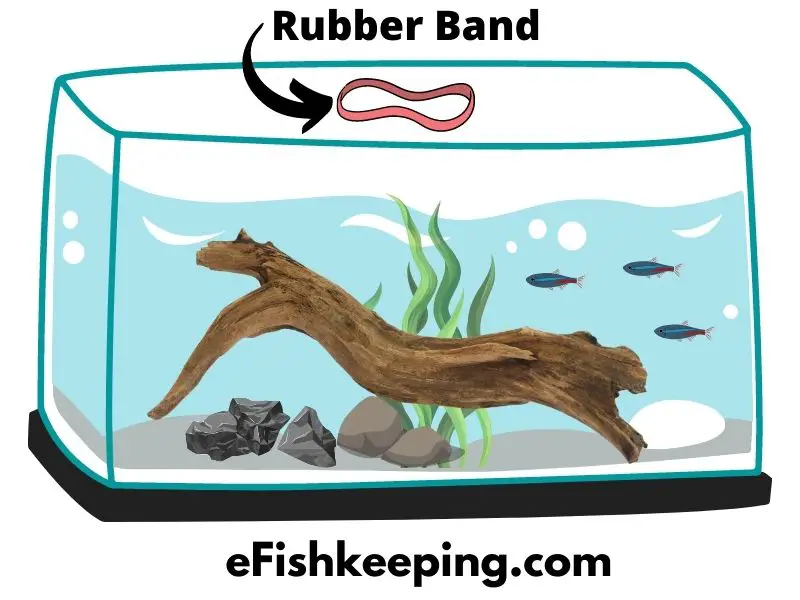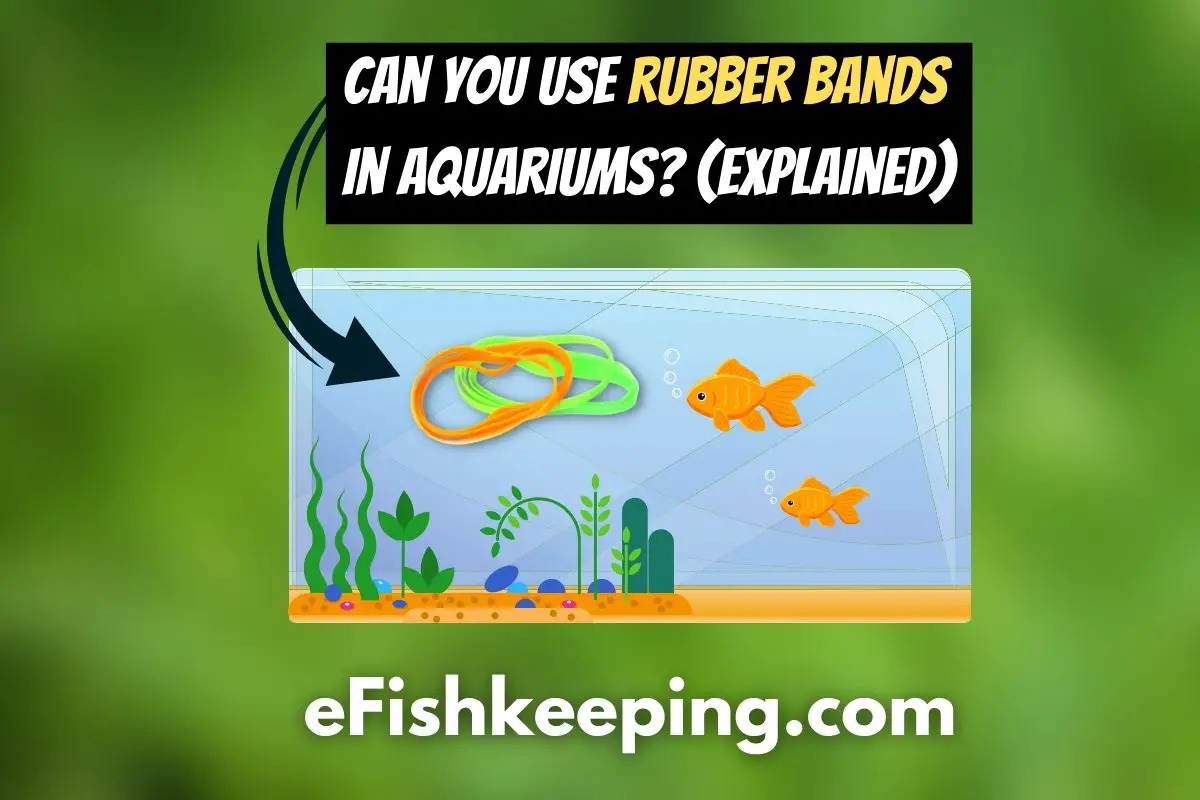If you’ve ever tried to keep plants or other items in place in your tank and struggled, you might have wondered, can you use rubber bands in aquarium setups? It is important to check before adding manmade materials that might not be suitable, so let’s find out!
Many people use rubber bands in their aquariums without any issue, and these are generally considered a fish-safe option. However, you should remove any that are fraying or breaking down and avoid having any loose bands that a fish could get trapped in.

Let’s find out a bit more about how you can use rubber bands in an aquarium and what you should avoid!
1. Can You Use Rubber Bands In Aquariums?
Many people use rubber bands in their aquariums without a problem, and if you are setting up your tank, you will probably find that you have uses for them.
They can be great for fastening plants in place, holding decorations together, and more.
It should be fine to use a rubber band or two in your aquarium, but you probably don’t want to fill the aquarium with them. Look at other alternative options for securing things, and be aware that rubber bands will not last indefinitely.
Rubber bands will slowly start to degrade in the water, and they will eventually fray and snap. This is unlikely to happen quickly, but bear in mind that a rubber band will not last forever. If you need something that will serve in the long term, consider a suitable aquarium glue or other options like fishing wire.
You should make sure that you use rubber bands that are plain and preferably clear/uncolored. These are less likely to contain harmful dyes or chemicals that could leach into the water. It is unlikely that a couple of rubber bands would be harmful even if they contained chemicals, but it’s better to be cautious than cavalier.
2. What Are The Dangers Of Using Rubber Bands?
On the whole, rubber bands are considered pretty safe, but there are a few things to think about. Make sure you consider:
- What the rubber band is made of
- Where the rubber band is placed
- How accessible the rubber band is to fish and other tank inhabitants
- What might happen if the rubber band breaks (e.g., will anything fall and present a danger to the fish?)
- Whether any creatures could get caught in the band
- Whether the rubber band is too tight for your plants’ stems
You should choose your rubber bands with care and avoid using ones that you have just lying around the home, as these may have already started to degrade and could therefore cause problems in the aquarium.
Safety is of utmost importance for your fish, so pay attention to these things and choose an alternative product if you aren’t sure. Some rubber bands are food safe, and this may mean that they are more suitable for use in an aquarium.
The plainer the rubber band is, the more likely it is to be safe.
3. What Should You Look For In Rubber Bands?
You could ask your local aquarium store if they have any suggestions, but if not, make sure you avoid rubber bands that:
- Are brightly colored
- Have metal grips that will rust (e.g., a hairband)
- Are worn out already
- Are made of unsafe materials (if you can find this out)
If you plan to use a lot of rubber bands in your tank, it may be worth sourcing some that are specifically designed for use in aquariums rather than using normal rubber bands.
4. When Should You Remove Rubber Bands?
It’s a good idea to regularly check on the rubber bands in your aquarium and remove them when they are starting to look worn out or fraying at the edges. Make this part of your tank maintenance routine.
If you find that a band has started to wear out, take a pair of small, sharp scissors and cut it off. This is often easier than trying to untangle it. You can then replace the rubber band if necessary or – if used to help a plant root – leave it if no attachment is needed anymore.
Don’t leave rubber bands in the water once they have started to degrade. If small fragments break off, your fish are likely to try to eat them, and this could be harmful. Remove decaying bands and replace them as necessary.
If you seem to be doing this constantly, it may be because you are using low-quality rubber bands that turn brittle too quickly.
Consider swapping for a higher quality option or use an alternative product that will last longer. This can reduce your tank maintenance and make life easier.
5. Why Are Rubber Bands Useful?
Rubber bands have a whole range of uses in aquariums. Many people use them for anchoring plants in the right positions. You can attach plants to driftwood or bunch them up and fix them in place while they anchor themselves to the bottom.
Rubber bands can also be used to attach nets over filters or to secure barriers in place. They may work in other situations too. Some people even use rubber bands to hold together food snacks that they offer to their fish, making it easier to remove any leftover food when the fish have finished with it.
You may have further uses in mind, and any should work as long as you are vigilant about removing the bands when they decay.
6. What Other Ties Can You Use?
If you would rather not use rubber bands, there are plenty of alternatives. For example, silicon bands may work, or you could try clips, twist ties, fishing line, zip ties, or even string or twine.

Check This Here (on Amazon)
Most of these will break down when they are left in the water for extended periods, but you can simply replace them when they do. Many of these options have the additional advantage that – unlike a rubber band – they will not become slack as time passes.
A rubber band may hold something very tightly to begin with, but it will often gradually loosen, and this makes it less suitable for use in an aquarium.
It may even be too tight when first used; bands can easily damage the stems of tender plants. The alternative options will offer as much grip when they have been in the tank for months as they do at the start.
You may therefore find that string, silicon bands, or other items are more suitable for use in your aquarium. They may not be as readily available (or perhaps as cheap) as rubber bands, and some of them are harder to apply, but they do have some advantages too.
7. What If My Fish Try To Eat Them?
Sometimes, you may find that your fish or other tank inhabitants take an interest in your rubber bands. This is something that you should pay attention to and discourage if possible.
A fish could harm itself by ingesting rubber bands (which will not break down in its system), and is also at risk of getting tangled up and injured.
If one of your tank inhabitants seems very interested in a rubber band and is sucking or biting at it, consider whether you can block its access to it. You might want to bury a plant deeper, add some surrounding rocks, or relocate the item.
If this isn’t feasible, you may need to remove the rubber band and try an alternative product. You really don’t want your aquarium inhabitants to try to eat the rubber bands, so you’ll need to take some action if they are too interested.
Conclusion
Using rubber bands in an aquarium is generally considered safe as long as the bands are plain, the fish are disinterested in them, and they get replaced when they start to decay. Avoid brightly colored or worn-out bands, and keep an eye on your tank inhabitants to make sure they aren’t eating them or at risk of getting tangled up in them.
I think you’ll also like reading:
Hi! I’m Praveen Ghoshal, the founder of eFishkeeping.com. Inspired by my Dad, I got interested in fishkeeping when I was a kid. Since then, I have been involved with this hobby. Currently, I have 3 fish tanks at our home, and I enjoy this hobby with my full family. Read more about me here.







